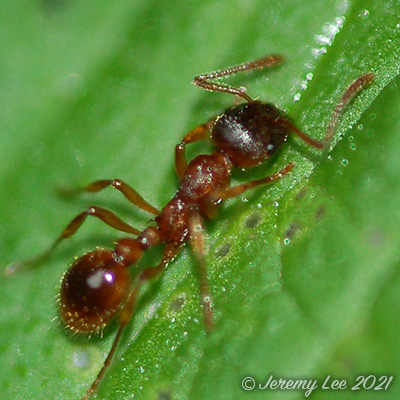
 |
|
Scientific Classifications explained » Amphibians » Ants » Aphids » Bees » Beetles » Birds » Bugs » Butterflies » Caterpillars » Damselflies » Dragonflies » Earwigs » Flies » Frog/Leafhoppers » Fungi » Galls » Grasshoppers » Harvestmen » Hoverflies » Lacewings » Ladybirds » Leaf Mines » Lichens » Mammals » Millipedes » Mosses » Moths » Sawflies » Slugs » Snails » Spiders » Trees & Shrubs » Wasps » Wild Flowers » Woodlice » Postboxes |
UK Nature > Ants > Myrmica rubra

Scientific Name: Myrmica rubra Common Name: Common Red Ant Myrmica rubra, more commonly known as the Common Red Ant, is very often found under stones and logs in the garden, and also in soil and lawns. Approximately 6 mm long, they are mainly red in colour, with slightly darker pigmentation on the head. The males are a little darker than the others. Lasius ants always have just a single segment waist, whereas Myrmica have two segments. They nest under walls and old tree stumps or even paving slabs. Like all British ants it lives in colonies. Most of the inhabitants of a colony are females and have no wings. These do all the work, gathering food and tending the eggs. It is active throughout the year, but winged adults swarm in late summer during hot and humid weather; these 'flying ants' mate and eventually disperse to form new colonies. Red ant workers have a surprisingly painful sting and will attack if disturbed. Common and widespread in the UK. |
|

https://www.uknature.co.uk is a website dedicated to showing the immense diversity of UK nature and wildlife. Our vast range of habitats, from lowland arable to snow covered mountains, from storm-ravaged coastlines to peaceful inland freshwater lakes and rivers, from dry, sandy heaths to deciduous and coniferous forests, all these habitats contribute to the abundance of UK nature. We have wild birds in huge numbers either residing or visiting our shores (597 recorded species as at July 2013) and we must also not forget the humble back garden with its grass lawns, flower beds filled with nectar rich flowers, shrubs and trees, all designed to attract huge numbers of insects such as bees, moths, butterflies and hoverflies; and finally the small ponds which provide safe havens for frogs, toads, newts and even slow worms and grass snakes. www.uknature.co.uk is the showcase for my personal passion, photographing uknature in all its glory. I sincerely hope you all enjoy the fruits of my labours. This site and all images contained therein is © Jeremy Lee 2004 - 2025. All Rights Reserved. Site design by Jeremy Lee. Site development & IT Support by Stuart Lee. |